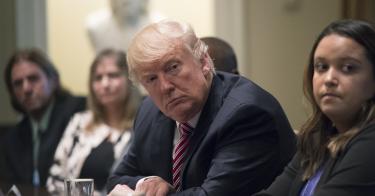Representation, rule of law, and separation of powers—these concepts are central to the American system of constitutional government. Yet they have been threatened for much of the last century by the proliferation of independent government agencies. Congress has enabled these agencies to become, essentially, an unaccountable fourth branch of government, one that performs legislative, executive, and judicial functions.
Passage of the 2010 Dodd-Frank Wall Street Reform and Consumer Protection Act continued this unfortunate trend. It created a new, independent agency—the Consumer Financial Protection Bureau (CFPB)—and gave it unparalleled rulemaking, supervisory, and enforcement powers over virtually every consumer financial product and service.
That was a bridge too far for some in the judicial branch.
Last October, a three-judge panel of the U.S. Circuit Court of Appeals ruled that the bureau’s single-director model is unconstitutional. The decision states that the unilateral power wielded by CFPB Director Richard Corday “poses a far greater risk of arbitrary decision making and abuse of power, and a far greater threat to individual liberty, than does a multi-member independent agency.”
An agency such as the CFPB has no place in the American system of government.
The Financial CHOICE Act, recently passed in the U.S. House of Representatives, would greatly improve the structure and accountability of the CFPB.
The Trump administration has indicated it supports these policy changes. Treasury’s recently released financial regulatory report explicitly recommends, among other reforms, making the CFPB director removable at-will by the president, funding the CFPB through the regular appropriations process, and repealing the CFPB’s supervisory authority.
Unfortunately, the Senate has not yet indicated that it will support these changes, and many observers think that the CHOICE Act will stall in the upper chamber. They see the Senate’s 60-vote threshold as an insurmountable hurdle because Democrats won’t support repealing large chunks of Dodd-Frank.
But there is another route to passage. Using the budget reconciliation process, Senate Republicans could pass key sections of the CHOICE Act—perhaps even the entire bill—with only the 52-seat majority they currently hold.
The nonpartisan Congressional Budget Office (CBO) has given the Senate a green light to take that route. Its recent report on the Financial CHOICE Act estimates that “enacting the legislation would reduce federal deficits by $24.1 billion over the 2017-2027 period.”
The CBO report further shows that restructuring the CFPB is one of the biggest deficit-reducing reforms in the CHOICE Act.
While America waits for the Senate to act, there are few things the Trump administration can do to rein in the CFPB. Unfortunately, Congress gave the Bureau such broad authority, the administration’s ability to slow the CFPB’s rules through the Financial Stability Oversight Council (FSOC) is extremely limited.
Larger reforms may have to wait until President Trump can appoint a new CFPB director. (The term of the current director, Richard Cordray, expires in July 2018. However, he is widely expected to resign before then to run for governor of Ohio.)
A new CFPB director would have the rulemaking authority to reopen previously finalized CFPB rules, but fixing harmful rules in this manner is likely to be a long and arduous process. Permanent legislative fixes would be far superior.
Nonetheless, if the Senate takes too long to implement the reforms outlined in CHOICE and by Treasury, a new CFPB Director could, for example, revisit the so-called qualified mortgage (QM) rule that was finalized in 2013.
The QM rule essentially gave lenders a safe harbor from running afoul of the CFPB’s ability-to-repay requirements if they make loans that fit the QM standards. However, the CFPB decreed that all loans purchased by Fannie Mae and Freddie Mac automatically meet the QM standards, thus providing an advantage to lenders making these loans. (See page 6409.)
A new CFPB director could increase fairness and competitiveness in the home mortgage market by eliminating this preference.
Other provisions in Title X of Dodd-Frank (12 U.S. Code § 5512(b)(3)(A) and 12 U.S. Code § 5512(b)(3)(B)), would allow a new director to provide exemptions from several other of the CFPB’s rules. For instance, to improve access to financial products and services while maintaining adequate protections, the new director could provide exemptions to the CFPB’s prepaid card rule.
In particular, he could raise the de-minimis reporting exemption for firms from 3,000 to 6,000 accounts, and allow all but the largest providers to use the simpler, short-form disclosures. In theory, there is no limit to how many CFPB rules could be amended to lessen the regulatory burden. But there are some limits.
For instance, while Title X of Dodd-Frank transferred authority over the Electronic Fund Transfer Act (EFTA) to the CFPB, it also provided a carve-out for the Federal Reserve to implement the Durbin Amendment. Thus, to amend the Durbin price control before Congress acts, the Trump administration would likely have to nominate a majority of the seven members of the Board of Governors.
Then, the administration could, in theory, exempt from the price control all retail transactions originating with retailers who have more than $3 billion in revenue.
Though nominating a majority of the Board is an unusual opportunity, three vacancies (including the Vice Chair of Supervision) currently exist, and Chair Yellen’s term expires in February of 2018.
None of these administrative reform options is optimal. Far better for Congress to eliminate the CFPB as it currently exists. But rather than passively wait for Congress to act, the Trump administration should consider using its limited authority to mitigate the harm caused by Dodd-Frank.
In the meantime, Americans will have to wait for Senate Majority Leader Mitch McConnell (R-Ky.) and Senate Banking Chairman Mike Crapo (R-Idaho) to push for reforms that will strengthen financial markets, end bailouts, protect taxpayers, and roll back Dodd-Frank’s assault on the constitution.
This piece originally appeared on Forbes.com



